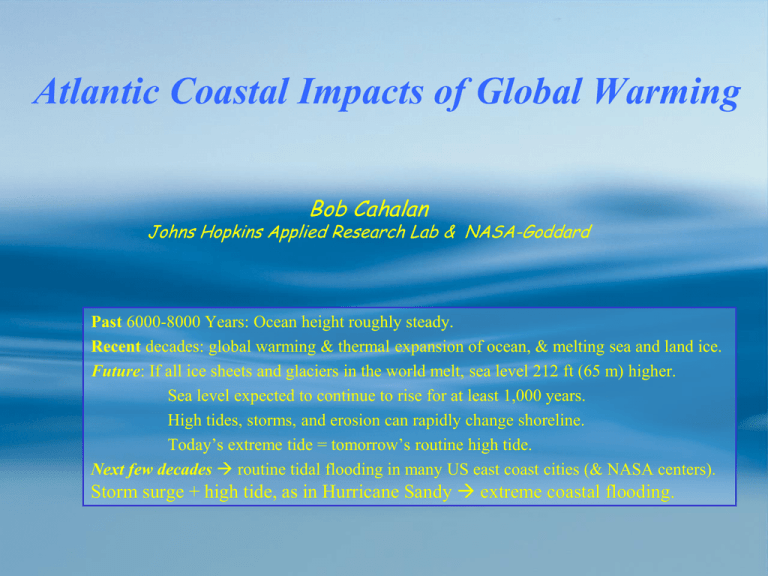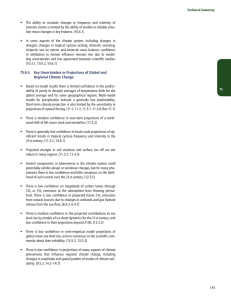
Atlantic Coastal Impacts of Global Warming
Bob Cahalan
Johns Hopkins Applied Research Lab & NASA-Goddard
Past 6000-8000 Years: Ocean height roughly steady.
Recent decades: global warming & thermal expansion of ocean, & melting sea and land ice.
Future: If all ice sheets and glaciers in the world melt, sea level 212 ft (65 m) higher.
Sea level expected to continue to rise for at least 1,000 years.
High tides, storms, and erosion can rapidly change shoreline.
Today’s extreme tide = tomorrow’s routine high tide.
Next few decades routine tidal flooding in many US east coast cities (& NASA centers).
Storm surge + high tide, as in Hurricane Sandy extreme coastal flooding.
20,000 years ago, at the peak of the last ice age cycle, sea level was 390 feet (120 m) lower
than present and Florida was roughly twice the current size.
120,000 years ago, at the last warm point in the natural climate cycle, sea level reached
approximately 25 feet (8 m) higher than present, making the state less than half its current
size.
20,000 Years Ago
47th Floor
Miami Tower
“Bank of America”
30th Floor
When all ice melts
212 ft (65 m)
Present Sea Level
390 ft
(120 m)
20,000 years ago
Last Ice Age
Location
Feet
Mete
rs
East
Antarctic
169
51.6
West
Antarctic
15
4.5
Antarctic
Peninsula
2
0.5
Greenland
24
7.3
Other
glaciers,
etc
2
0.6
Total Ice
melting
212
64.5
Antarctic Melt-down ?
11,800 ± 3,900 km2/yr
Recent Decades
Goddard Climate & Radiation
Laboratory
branch CS roles, issues & concerns
Strengths
Challenges
Opportunities
Ash Wednesday Storm, March 6-8, 1962
-------------------Threats
”50 years ago, Ocean City was washing away”
-------------------– Baltimore Sun, March 5, 2012
Visit baltimoresun.com at http://www.baltimoresun.com
"My 2011-2012 VT winter season,
when the ground was frozen, was a
mere 67 days, instead of 150 days.
Watch what is happening to the
Arctic ice - and here is the June snow
record looking like terminal collapse.
”
Holland Island The last house on Holland Island in the Chesapeake Bay as it stood in October 2009.
It fell into the bay a year later. The owners held on until almost the last possible minute.
Far Rockaway, NY The top image shows Far Rockaway, NY before Hurricane Sandy.
The bottom image shows the same neighborhood after Hurricane Sandy hit.
Sea Level Change: Projections v. Actual How good are SLR projections? IPCC published SLR projections
in 1990 and in 2002, shown above as the fairly straight upper and lower boundary lines starting in 1990 and 2000
The yellow squiggly line starting on the far left is sea level measured by tide gauges. The red line running
through that from the mid 90’s is satellite altimeter data. The highest projections barely include the actual sea lev
The IPCC projections for SLR are consistently low, a good indicator that future projections will continue
the same pattern. (From Rahmstorf, 2012.)
Last half century
continues the
pattern:
CO2, global
temperature, and
sea level are all
rising
© 2015 John Englander and Trunity Holdings. All Rights Reserved
Flooding in the famous St. Mark’s Square, Venice, Italy on September 18, 2009 For the last three decades,
these have become increasingly routine, known locally as alta acqua, or high water.
Chapter 6:
What We Can Do
Galveston Seawall that lines Galveston's beaches is ten miles long and seventeen feet high.
Rhode Island Hurricane Barrier The Fox Point Hurricane Barrier is a tidal flood barrier
spanning Providence River in Providence, Rhode Island. The barrier is 3,000 feet (915 m) long
and 25 feet (8 m) high, consisting of gates, dikes, and a pumping station.
Stiltsville in Biscayne Bay A group of houses built on stilts in Biscayne Bay off the coast of Miami.
Boston’s Safety Belt an innovative solution to the problem of rising sea level in that highly vulnerable city.
In spite of winning first place in a design competition in 1988, the plan gathers dust on a shelf.
What choices are being made?
VIEW current and expected climate changes along our coasts:
Nature and human development is directly altering the landscape, and also now people are indirectly
altering the landscape, via greenhouse gas emissions, causing Nature to respond in ways likely to make
hundreds of millions or a billion humans homeless. Florida state government reportedly avoids use of
the term 'sea level rise’ in government documents. That's easy to understand, when you see the probable
future of Florida: Within this century, Miami may become the "Drowned City." Within this millenium,
Florida may become the "Drowned State." Stage 1: denial.
A climate wave is arriving.
Will we wipe out …
… or ride the wave?





